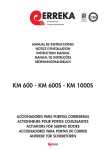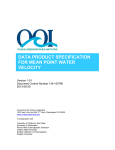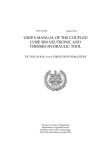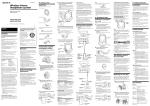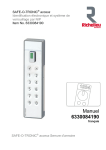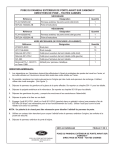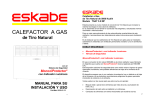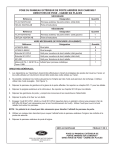Download TB USA Rev 2000 completo
Transcript
OWNER’S OPERATION AND INSTALLATION MANUAL FOR MODELS GRAVITY DIRECT VENT WALL FURNACE DVEL 8, DVEL 12, DVEL 20 WARNING: If the information in this manual is not followed exactly, a fire or explosion may result causing property damage, personal injury or loss of life. AVERTISSEMENT. Assurez-vous de bien suivre les instructions données dans cette notice pour réduire au minimum le risque d’incendie ou d’explosion ou pour éviter tout dommage matériel, toute blessure ou la mort. Do not store or use gasoline or other flammable vapours and liquids in the vicinity of this or any other appliance. Ne pas entreposer ni utilliser d’essence ni d’autres vapeurs ou liquides inflammables dans le voisinage de cet appareil ou de tout autre appareil. WHAT TO DO IF YOU SMELL GAS • Do not try to light any appliance. • Do not touch any electrical switch; do not use any phone in your building. • Immediately call your gas supplier from a neighbour’s phone. Follow the gas supplier’s instructions. • If you cannot reach your gas supplier, call the fire department. QUE FAIRE SI VOUS SENTEZ UNE ODEUR DE GAZ: • Ne pas tenter d’allumer d’appareils. • Ne touchez à aucun interrupteur. Ne pas vous servir des téléphones dans le bâtiment où vous vous trouvez. • Appelez immédiatement votre fournisseur de gaz depuis un voisin. Suivez les instructions du fournisseur. • Si vous ne pouvez rejoindre le fournisseur de gaz, appelez le service des incendies. L’installation et l’entretien doivent être assuré par un installeteur ou un service d’entretien qualifié ou par le fournisseur de gaz. Installation and service must be performed by a qualified installer, service agency or the gas supplier. This appliance may be installed in an aftermarket, permanently located, manufactured home (USA only) or mobile home, where not prohibited by local codes. This appliance is only for use with the type of gas indicated on the rating plate. This appliance is not convertible for use with other gases, unless a certified kit is used. Cet appareil peut être installé dans une maison préfabriquée (É.-U. Seulement) ou mobile déjà installée à demeure si les règlements locaux le permettent. Cet appareil doit être utilisé uniquement avec le type de gaz indiqué sur la plaque signalétique. Cet appareil ne peut être converti à d´autres gaz, sauf si une trousse de conversion est utilisée. 1 CONTENT Section Preface Product Identification Product Features Installation Gas Piping Operation Cleaning and Maintenance Troubleshooting Service and Maintenance Parts List Page 1 2 3 4-9 10-11 11-14 14-15 16-18 18 19-23 This gas appliance must not be connected to a chimney flue serving a separate solid-fuel burning appliance. IMPORTANT FOR YOUR SAFETY • Improper installation, adjustment, alteration, service, or maintenance can cause property damage, personal injury or loss of life. Refer to this manual. • Installation and service must be performed by a qualified installer, service agency, or the gas supplier. Do not use this appliance if any part has been under water. Immediately call a qualified service technician to inspect the appliance and to replace any part of the control system and any gas control which has been under water. Ne pas se servir de cet appareil s’il a été plongé dans l’eau, complètement ou en partie. Faire inspector l’appareil par un technicien qualifié et remplacer toute partie du système de contrôle et toute commande qui ont été plongées dans l’eau. PRODUCT IDENTIFICATION Figure 2 2 PRODUCT FEATURES GAS SPECIFICATIONS Model No. DVEL 8N DVEL 8L DVEL 12N DVEL 12L DVEL 20N DVEL 20L Input Power * Btu/Hr. / (kW) 8,000 / (2.32) 8,000 / (2.32) 11,000 / (3.20) 11,000 / (3.20) 17,000 / (4.94) 17,000 / (4.94) Max. Gas Min. Gas Pres. Reg. Inlet Pres. Inlet Pres.** Settings In. W.C. / In. W.C. / In. W.C. / (mm. W.C.) (mm. W.C.) (mm. W.C.) 10,5 / (267) 4,5 / (114) 3,5 / (89) 14 / (355) 11 / (280) 10 / (254) 10,5 / (267) 6,4 / (162) 5,4 / (137) 14 / (355) 11 / (280) 10 / (254) 10,5 / (267) 4,5 / (114) 3,3 / (84) 14 / (355) 11 / (280) 10 / (254) Valve Type Manual (COPRECI 18700) Manual (COPRECI 18700) Thermostatic (SIT 630) Thermostatic (SIT 630) Thermostatic (SIT 630) Thermostatic (SIT 630) * REMARK: Appliance input ratings are based on sea level operation and need not be changed for operation up to 2000 feet (609.9 m) elevation. For operation at elevation above 2000 feet (609.9 m) manufactured to specified deration conditions for Canada and the United States. **NOTE: Minimum Gas Inlet Pressure for purpose of input adjustment. The efficiency rating of the appliance is a product thermal efficiency rating determined under continuous operating conditions and was determined independently of any installed system. UNIT SPECIFICATIONS Model No. DVEL 8N DVEL 8L DVEL 12N DVEL 12L DVEL 20N DVEL 20L Dimensions Inch / (mm) Height: Width: Depth: Height: Width: Depth: Height: Width: Depth: 20 / (508) 13 5/8 / (346) 7 3/8 / (187) 20 / (508) 17 3/8 / (441) 7 5/8 / (194) 20 / (508) 27 3/8 / (695) 8 3/8 / (213) No. of Burner Ignition s Weight Lbs. / (kg.) Type of Burner 27 / (12.2) Atmospheric 1 33.7 / (15.3) Atmospheric 1 48.7 / (22.1) Atmospheric 2 Model DVEL 8 Piezoelectric ignitor Piezoelectric ignitor Piezoelectric ignitor Model DVEL12 Model DVEL 20 3 Standard Heating Space Square Feet / (m2) 200 / (18.6) 275 / (25.6) 425 / (39.5) PRODUCT FEATURES (CONTINUED) NOTICE A qualified service person must install the heater. Follow all local codes. CHECK GAS TYPE Use only the type of gas indicated on the rating plate. INSTALLATION INSTALLATION ITEMS Before installing heater, make sure you have the items listed below. n Piping (check local codes) n Sealant (resistant to propane gas) n Manual shutoff valve n Ground joint union n Test gauge connection n Sediment trap n Tee joint n Pipe wrench The installation location shall provide the following; a) adequate combustion and ventilation air, and b) adequate accessibility clearances for servicing. MINIMUM CLEARANCE FROM COMBUSTIBLE CONSTRUCTION Rear............................... 0 Inches/0mm (to bracket) Sides.............................. 6 Inches/152mm Top................................. 36 Inches/914mm Floor............................... 6 Inches/152mm (to top of carpeting, tile, etc.) Figure 4 NOTICE: Maintain the minimum clearances shown in figure 4. If you can, provide greater clearances from floor, ceiling and adjoining wall. 4 INSTALLATION (CONTINUED) This appliance may be installed in an aftermarket, permanently located, manufactured home (USA only) or mobile home, where not prohibited by local codes. This appliance is only for use with the type of gas indicated on the rating plate. This appliance is not convertible for use with other gases, unless a certified kit is used. IMPORTANT: This appliance should only be installed by a qualified installer. The installation must conform with local codes or, in the absence of local codes, with the National Fuel Gas Code, ANSI Z223.1, or Canadian Installation Code, CAN1-B149. Installer l’appareil selon les codes ou règlements locaux, ou en l’absence de tels règlements, selon les codes d’installation Canadian Installation Code, CAN1-B149. A manufactured home (USA only) or mobile home OEM installation must conform with the Manufactured Home Construction and Safety Standard, Title 24 CFR, Part 3280, or, when such standard is not applicable, the Standard for Manufactured Home Installations, ANSI Z 225.1, or Standard for Gas Equipped Recreational Vehicles and Mobile Housing, CSA Z 240.4. IMPORTANT • • • • • • The appliance area must be kept clear and free from combustible materials, gasoline, and other flammable vapors and liquids. Due to high temperatures, the appliance should be located out of traffic and away from furniture and draperies. Children and adults should be alerted to the hazards of high surface temperature and should stay away to avoid burns or clothing ignition. Young children should be carefully supervised when they are in the same room as the appliance. Clothing or other flammable material should not be placed on or near the appliance. Any safety screen or guard removed for servicing an appliance must be replaced prior to operating the appliance. Installation and repair should be done by a qualified service person. The appliance should be inspected before use and at least annually by a qualified service person. More frequent cleaning may be required due to excessive lint from carpeting, bedding material, etc. It is imperative that control compartments, burners and circulating air passageways of the appliance be kept clean. WARNING: Failure to position the parts in accordance with these diagrams, or failure to use only parts specifically approved with this appliance may result in property damage or personal injury. AVERTISSEMENT: Risque de dommages ou de blessures si les pièces ne sont pas installées conformément à ces schemas et ou si des pièces autres que celles spécifiquement aprouvées avec cet appareil sont utilisées. INSTALLING THE APPLIANCE Separate the hanging bracket from the appliance by removing two screws on the top and two nuts at the bottom. INSTALLING THE HANGING BRACKET ON A NON-COMBUSTIBLE WALL (i.e., MASONRY BLOCK OR CONCRETE) 1. Draw the position of the hole for the air-vent intake pipe, taking into account the minimum clearances mentioned in figure 4. See diameter of the hole “D” and height to the center “C” in table 1 and figure 5 for the different models. Height “C” is the minimum recommended. 5 INSTALLATION (CONTINUED) TABLE1 MODEL DVEL 8N - DVEL 8L DVEL 12N - DVEL 12L DVEL 20N - DVEL 20L C 19 ½” (495 mm) 19 ½” (495 mm) 19” (483 mm) D 6 ¾” (172 mm) 7 ¾” (197 mm) 8 ¾” (222 mm) Figure 5 2. 3. 4. 5. 6. Figure 6 Drill through the wall according to measurements and positions indicated. Place hanging bracket over the hole. After leveling the hanging bracket, mark the four holes as shown in figure 6. Remove the hanging bracket and drill the four holes. Insert in each hole the anchors provided. Place back the hanging bracket and fix it with four screws. INSTALLING THE HANGING BRACKET ON A WOODEN WALL 1. 2. Taking into account the minimum clearances mentioned in figure 4, locate the closest wall stud (which will serve to hold the appliance) and mark the hole center at a distance “A”, (if wall stud is at the right), or “B”, (if the stud is at the left). See table 2 and figures 7 and 8. Draw the position of the hole for the vent-air intake pipe. See diameter of the hole “D” and height to the center “C” in table 2 for the different models. Height “C” is the minimum recommended. TABLE 2 MODEL DVEL 8N - DVEL 8L DVEL 12N - DVEL 12L DVEL 20N - DVEL 20L A 5 9/16” (141 mm) 7 13/16” (198 mm) 13 11/64” (335 mm) B 3 31/32” (101 mm) 5 7/16” (138 mm) 10 7/8” (276 mm) Figure 7 C 19 ½” (495 mm) 19 ½” (495 mm) 19” (483 mm) Figure 8 6 D 6 ¾” (172 mm) 7 ¾” (197 mm) 8 ¾” (222 mm) INSTALLATION (CONTINUED) 3. 4. Drill through the wall according to measurements and positions indicated. Place wall bracket over the hole. After leveling the hanging bracket, mark the four holes as shown in figures 9 and 10. Figure 9 5. 6. 7. Figure 10 Remove the hanging bracket and drill the four holes. Insert in each hole the anchors provided. Place back the hanging bracket and fix it with four screws. MOUNTING THE HEATER ON HANGING BRACKET Place the heater on the hanging bracket and fix it with its screws. (See Figure 11 and 12). Figure 12 Figure 11 ATTENTION: THE ATTACHED SET OF THREE MARKING PLATES (RATING PLATE, OPERATION INSTRUCTIONS, AND SAFETY PLATE) MUST NOT BE REMOVED FROM THE APPLIANCE AT ANY TIME. Figure 13 7 INSTALLATION (CONTINUED) INSTALLING THE VENTING SYSTEM These models of wall furnaces are designed for direct venting through a wall. Only venting components specifically approved for these furnaces may be used. The flow of combustion gases and ventilation air must not be obstructed. Minimum clearance between pipes and combustible materials is one (1) inch (25.4 mm). Vent terminal must be 18.0” away from an adjacent wall. Minimum clearance between vent cap and combustible material 1 ¾”. IMPORTANT: The appliance’s venting system should be inspected at least once a year and immediately cleaned if necessary. IMPORTANT: THE VENT-AIR INTAKE SYSTEM MUST BE PROPERLY INSTALLED TO INSURE PROPER AND SAFE OPERATION. THE VENT-AIR INTAKE SYSTEM MUST ALSO BE PROPERLY RE-INSTALLED AND RESEALED TO INSURE PROPER AND SAFE OPERATION. Warning: Failure to position the parts in accordance with these diagrams or failure to use only parts specifically approved with this appliance may result in property damage or personal injury. Avertissement: Risque de dommages ou de blessures si les pièces ne sont pas installées conform´ment à ces schémas et ou si des pièces autres que celles spécifiquement approuvées avec cet appareil sont utilisées. CAUTION: ALL JOINTS MUST BE AIR-TIGHT. The venting system consists of: one injected-aluminum cap (A), one vent pipe (B), one vent-air intake pipe (C), one rod (D), one nut (E), one outdoor mounting plate (F) and one silicon-rubber ring (G). (See figure 14). Figure 14 1. 2. Measure thickness of the wall as shown in figure 15. If pipes (B), (C) and the rod are long, trim them according to thickness of the wall, as shown in the following table. TABLE 3 Lengths of pipes and rod. 3. 4. 5. 6. Figure 15 vent pipe (B) wall thickness + 3 3/8“ (86 mm) vent-air intake pipe (C) wall thickness + 2 1/2“ (64 mm) Rod (D) wall thickness + 5 7/8“ (149.5 mm) The hole at the outside of the wall must be a square of 11 ½” (290 mm) x 11 ½” (290 mm). (See figure 17). From the outside of the wall, screw the rod slightly onto support located inside the appliance flue outlet. Slide pipes (B) and (C) through the hole in the wall, and connect them to the appliance flue outlet and air intake, respectively. The outdoor mounting plate and the silicon-rubber ring should be installed between the vent cap and the exterior wall. The plate must be positioned flush to the wall and with its standoffs inserted into the wall and sealed with a non-hardening mastic (silicone caulk). (See figure 17). Position the outdoor mounting plate so that the vent-air intake pipe has a slight downward slope to the outside. The downward slope is necessary to prevent the entry of rainwater. 8 INSTALLATION (CONTINUED) 7. 8. Before attaching the vent cap to the exterior wall, run a bead of non-hardening mastic (silicone caulk) around its outside edge, so as to make a seal between it and the plate. (See figure 17). Place cap and screw nut “E”, until cap leans against the plate. (See figures 16 and 17). Figure 16 Figure 17 INSTALLING THE THERMOSTAT SENSOR (MODELS DVEL12 AND DVEL20) In order to protect the thermostat sensor from any damage during shipping, or while handling it before it is definitely installed, the thermostat sensor has not been attached to its final location in the appliance. So, once the heater is installed, the thermostat sensor must be placed and secured in position. To do so, follow these steps: 1. Separate the front panel of the appliance by removing the two nuts in the bottom and sliding it up as shown in figure 18. 2. Place the thermostat sensor under the right bottom of the bracket and fix it with the same nut that fixes the appliance to bracket as shown in figures 19 and 20 Figure 18 Figure 19 Figure 20 9 GAS PIPING Gas Connection 1) We recommend using only new black iron or steel pipe. CHECK LOCAL CODES. 2) The gas supply line shall be sized and installed to provide a sufficient supply of gas to meet the maximum demand of the heater without undue loss of pressure. 3) The sealant used on the threaded joints of the gas pipe must be a type resistant to the action of L.P.Gas. (This sealant should be applied lightly to main threads to ensure excess sealant does not enter lines.) 4) The supply system must include a manual shut off valve and connection in the line, so the heater can be disconnected for servicing. (See Figure 21). 5) Include a drip leg (trap) and a plugged 1/8” N.P.T. tapping in the line. The tapping should be accessible for test gauge connections upstream of the gas supply connection to the heater. Figure 21 WARNING: For L.P.Gas, use PRESSURE REGULATED gas supply. Do not directly connect LP supply tank to the pressure regulator on the heater. The LP supply tank must have its own separate pressure regulator that can reduce the supply tank gas pressure down to a maximum of 14 inches (355 mm) of water column pressure. IMPORTANT: Hold the gas inlet of the appliance with wrench when connecting it to gas piping and/or fittings. CHECK AFTER GAS CONNECTION WARNING: All gas piping and connections must be tested for leaks after installation or servicing. All leaks must be corrected immediately. 1. 2. 3. Make sure the control of the heater is in the “OFF” position. Open the manual shut off valve. Test for leaks by applying liquid detergent to all joints. Check all joints from gas meter to thermostat gas valve. (Bubbles forming indicate a gas leak) Correct any leak defect at once. 10 GAS PIPING (CONTINUED) CAUTION: NEVER USE AN OPEN FLAME TO CHECK FOR LEAKS Pressure testing supply line ATTENTION: This appliance and its appliance main gas valve must be disconnected from the gas supply piping system during any pressure testing of that system at test pressures in excess of ½psi (3,5 kPa). The appliance must be isolated from the gas supply piping system by closing equipment shutoff valve during any pressure testing of the gas supply piping system at test pressures equal to or less than ½psi (3,5 kPa). OPERATION Read the following instructions carefully (you can also find them on the plates attached to the heater back): Lisez attentivment les instructions suivantes (vous les trouverez aussi les plaques jointes sur la partie derrière de l’appareil). 11 OPERATION (CONTINUED) Pilot Burner 12 ALLUMAGE Veilleuse POUR COUPER L'ADMISION DE GAZ DE L'APPAREIL 13 OPERATION (CONTINUED) CAUTION Do not try to adjust heating levels by using the manual shutoff valve. IMPORTANT • • • • • • • Do not dry clothes over the heater. Do not spray any aerosol near the heater when functioning. Do not store these elements near the appliance. Do not touch grill to avoid burns. Avoid blocking air inlet and hot air outlet. Do not spill water over the heater as it may cause corrosion or damage. Do not touch vent cap while heater is operating, to avoid burns. If you smell gas, shut off control valve, open doors and windows and do not light any electrical fixture near the heater. Call your Gas Supplier. NOTE: It is normal for the new wall furnace to give some odor the first time it is burned. This is due to the curing of the paint and any undetected oil from the manufacturing process. It is recommended to burn a new wall furnace for at least two (2) hours the first time that it is used. CLEANING AND MAINTENANCE WARNING Turn off heater and let cool before cleaning. CAUTION You must keep control areas and circulating air passageways of heater clean. Inspect these areas of heater before each use. Have heater inspected yearly by a qualified service person. Heater may need more frequent cleaning due to excessive lint from carpeting, bedding material, etc. Verify proper operation after servicing. S’assurer que l’appareil fonctionne adéquatement une fois l’entretien terminé. CABINET Exterior Use a soft cloth dampened with a mild soap and water mixture. Wipe the cabinet to remove dust. Air Passageways Use a vacuum cleaner or pressurized air to clean. Vent Cap Use a vacuum cleaner or pressurized air to clean. Pilot and Burner Periodically visually check the pilot and burner flames. (View flames through view port) Fig. 22 14 The correct flame pattern should be viewed by looking through the view port on top of the unit (Fig. 22). The correct flame pattern of pilot and main burner are shown in figures 23, 24, 25 and 26. PILOT FLAME THERMOCOUPLE PRIMARY FLAME: 1/4´´ - 3/8´´ (6 - 10 mm) Model DVEL 20 Models SECONDARY FLAME: 2´´ - 4´´ (50 - 100 mm) DVEL 8 and 12 Fig. 24 Correct pilot burner flame pattern Fig. 23 Correct main burner flame pattern SECONDARY FLAME PRIMARY FLAME PILOT FLAME THERMOCOUPLE Fig. 25 Correct main burner flame pattern (top view) Models DVEL 8 and 12 SECONDARY FLAME PRIMARY FLAME PILOT FLAME THERMOCOUPLE Fig. 26 Correct main burner flame pattern (top view) Model DVEL 20 Cleaning the Main Burner Orifice and Main Burner 1. 2. 3. 4. 5. 6. Turn OFF gas supply to the heater. Remove casing assembly. Disconnect burner tubing and remove orifice holder. Apply compressed air the orifice holder assembly to remove dust, lint or spider webs. Apply compressed air through the hole on the combustion chamber wall where the orifice holder was originally located to remove dust, lint or spider webs. As parts are being replaced in reverse order, check for gas leaks at all gas connections before replacing the casing assembly. 15 TROUBLESHOOTING WARNING Turn off heater and let cool before servicing. Only a qualified service person should service and repair heater. OBSERVED PROBLEM When ignitor button is pressed, there is no spark at pilot. When ignitor button is pressed, there is spark at pilot but no ignition. Pilot lights but flame goes out when control knob is released. POSSIBLE CAUSE 1) Ignitor electrode broken. REMEDY 1) Replace ignitor electrode. 2) Ignitor electrode not connected to ignitor cable. 3) Ignitor cable pinched or wet. 2) Reconnect ignitor cable. 4) Broken ignitor cable. 3) Free ignitor cable if pinched by any metal or tubing. Keep ignitor cable dry. 4) Replace ignitor cable. 5) Bad piezo ignitor. 5) Replace piezo ignitor. 1) Gas supply is turned off or manual shutoff valve closed. 2) Control knob not in PILOT position. 3) Control knob not pressed in while in pilot position. 4) Air in gas lines when installed. 1) Turn on gas supply or open manual shutoff valve. 2) Turn control knob to PILOT position. 3) Press in control knob while in PILOT position. 4) Continue holding down control knob. Repeat igniting operation until air is removed. 5) Pilot is clogged. 5) Clean pilot orifice or replace pilot assembly. 6) Gas regulator setting not correct. 6) Replace gas regulator. 1) Control knob not fully pressed in. 2) Control knob not depressed long enough. 3) Manual shutoff valve not fully open. 4) Thermocouple connection looses at control valve. 5) Pilot flame not touching thermocouple, which allows couple to cool, causing pilot flame to go out. This problem could be caused by one or both of the following: a) Low gas pressure. b) Dirty or partially clogged pilot. 6) Thermocouple damaged. 1) Press in control knob fully. 2) After pilot lights, keep control knob pressed in 30 seconds. 3) Fully open manual shutoff valve. 7) Control valve damaged. Replace control valve. 16 4) Hand tighten until snug, then tighten ¼ turn more. 5) a) Contact local gas company. b) Clean pilot or replace pilot assembly. 6) Replace thermocouple. TROUBLESHOOTING (CONTINUED) 1) Burner orifice is clogged. Burner does not light after pilot is lit. Delayed ignition of burner. Burner backfiring during combustion. Yellow flame during burner combustion. 2) Burner orifice diameter is too small. 3) Inlet gas pressure is too low. 1) Contact local Gas Company. 2) Burner or pilot orifice is clogged. 2) Clean burner or pilot orifice or replace it. 1) Clean burner orifice or replace it. 1) Burner orifice is clogged or damaged. 2) Gas regulator defective. 2) Replace gas regulator. 1) Inlet pipe is blocked. 1) Remove the blockage. 2) Incorrect connections of pipes. 1) Connect pipes according to installation instructions. 1) Replace gas regulator. Slight smoke or odor during 1) Residues from manufacturing initial operation. processes. 1) Turning control knob to HI position when burner is cold. 2) Air in gas line. Heater produces a whistling noise when burner is lit. 3) Dirty or partially clogged burner orifice. Heater produces a 1) Metal expanding while heating or clicking/ticking noise just contracting while cooling. after burner is lit or shut off. 1) Gas leak (see WARNING Heater produces unwanted statement below). odors. Gas odor even when control knob is in OFF position. 3) Contact local Gas Company. 1) Manifold pressure is too low. 3) Gas regulator defective Heater shuts off in use. 1) Clean burner orifice or replace burner orifice. 2) Replace burner orifice. 1) Problem will stop after a while of operation. 1) Turn control knob to LO position and let warm up for a minute. 2) Operate burner until air is removed from line. Have gas line checked by local Gas Company. 3) Clean burner orifice or replace it. 1) Low line pressure. 1) This is common with most heaters. If noise is excessive, contact qualified service person. 1) Locate and correct all leaks (see Checking Gas Connections, page 12) 1) Contact local Gas Company. 2) Pilot is partially clogged. 2) Clean pilot. 1) Gas leak. See WARNING statement below. 1) Locate and correct all leaks (see Checking Gas Connections, page 12) 2) Replace control valve. 2) Control valve defective. 17 TROUBLESHOOTING (CONTINUED) WARNING If you smell gas: n n n n n Shut off gas supply. Do not try to light any appliance Do not touch any electrical switch, do not use any phone in your building. Immediately call your gas supplier from a neighbor’s phone. Follow the gas supplier’s instructions. If you cannot reach your gas supplier, call the fire department. SERVICE AND MAINTENANCE WARNING Turn off heater and let cool before servicing. Verify proper operation after servicing. REPLACEMENT PARTS NOTE: In order for you to receive credit for parts replaced under warranty, only original replacements parts must be returned the authorized distributor. A) UNDER WARRANTY: Contact authorized dealers of this product. If they are unable to supply original replacement part(s), call the authorized distributor. Be prepared to indicate name, address, model number, and how heater was malfunctioning, type of gas used and purchase date. In most cases, the defective part will be requested to be returned to the authorized distributor. B) NOT UNDER WARRANTY: Contact authorized dealers of this product. If they are unable to supply original replacement part(s), call the authorized distributor. Be prepared to indicate model number and replacement part(s) number. When calling the authorized distributor have ready: n model number of your heater n the replacement part number Authorized Distributor in USA and Canada: 18 19 Model DVEL 8 19 20 Model DVEL 12 21 Model DVEL 20 PARTS LIST ITEM No. 1 2 3 4 5 6 7 8 9 10 11 12 13 14 15 16 17 18 19 20 21 22 23 24 25 26 27 28 29 30 31 32 33 34 PARTS No. DESCRIPTION DVEL 8 05070 DVEL 12 DVEL 20 05220 05325 02380101B 01196101A 05146 05262 05359 05046 05090 01212001 01090001 05175 05277 05386 05075 05225 05330 01192701 - 01190801B 01193602 010210C 01021001C 01021002C 05089 05245 05256 05134 05251 05338 01212401 -05232 - 01001901A 05078 -01021307 -01021301 05083 05228 05334 01082001 02230113 01082002 01081403 01082102 01081403 01141502 01143309 01143309 01090002 011433 011433 01021713D 011433 011433 01021714D 05152 05267 05385 01143301C 01194202 01194205 02340101 01143130 01022111B 05170 01160503 01001808 01001807A 01160502 01051402 05113 05266 05387 22 Front panel Mark Nut Grill guard Glass frame Lateral radiation shield Glass Gasket Combustion chamber Back Bolt and nut Nut Vent cap Vent-air intake pipe Vent pipe Rod Thermostat Sensor bracket Knob support Elbow 3/8 NPT x 3/8 NPT Elbow 1/4 BSP x 1/4 BSP Bracket Burner orifice Natural Gas Burner orifice L.P.G. Injector holder Pilot gasket Pilot assembly Natural Gas Pilot assembly L.P.G. Hanging bracket Thermocouple Ignitor wire Piezo-ignitor bracket Spring Knob position marking ring Spring Piezo-ignitor Outdoor mounting plate PARTS LIST (CONTINUED) ITEM No. 35 36 37 38 39 40 41 42 43 44 45 46 47 48 49 50 51 52 53 54 55 56 57 58 PARTS No. DVEL 8 02220702 DESCRIPTION DVEL 12 DVEL 20 02220705 01140701D 02100117E 01140908C 01212301 01210603 010003 05097 01190403 05269 05364 05268 05363 05257 05376 01160902 02830138B 02830140 02830137B 02830141B 011935A 02830139A 05240 --- 012123B ----05096 --01210408G 01210404G 05137 --02830110B 02830109B --01024001 05087 01052001 01052002 01160901 ---01143302 01143127 01143306 05100 --05101 05066 05201 -05355 02330101 01080406 01080405 --05246 23 Ignitor rod Control Knob Control panel Ignitor button Knob rod Adapter Washer Gas control valve bracket Bolt Gas control Valve Natural Gas Gas control Valve L.P.G. Top Radiation Shield Nipple 1/4 BSP x 3/8 NPT Burner tubing Pilot tubing Nut Gas main inlet tubing Radiation shield Pressure Regulator Natural Gas Pressure Regulator L.P.Gas Pressure Tap Fitting Front radiation shield Spark plug Pilot burner orifice Natural Gas Pilot burner orifice LPG Pressure regulator bracket Silicon-rubber ring Authorized Distributor in USA and Canada: ESKABE S.A. Cod. Mat.: XXXX.XX.XXX Ruta 2 No 323 (7600)Mar del Plata Pcia. de Buenos Aires Argentina 24

























